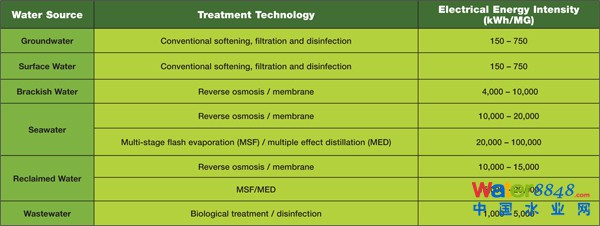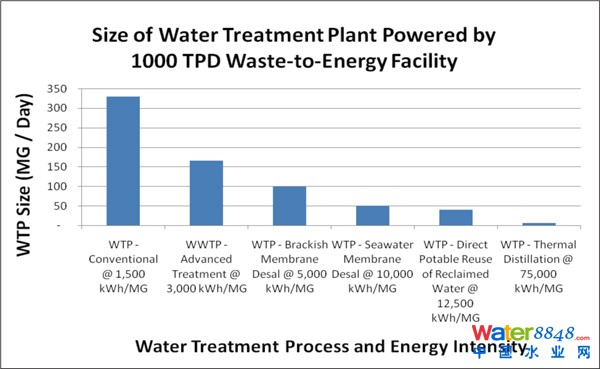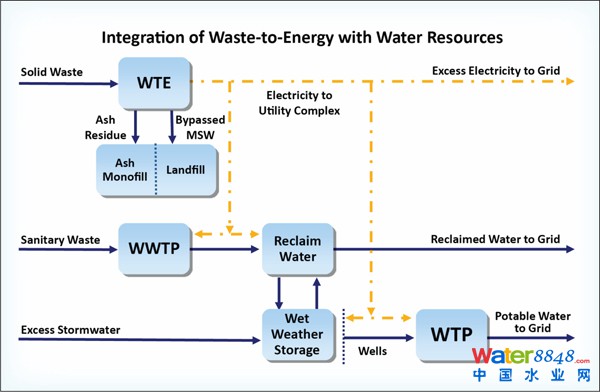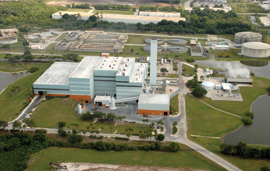面向21世纪的可持续的污水处理技术-水处理过程耦合降低碳足迹的废物再利用
By the year 2020, the future of an integrated solid waste management system will continue to evolve by reducing its carbon footprint and focusing on renewable energy in response to the global drive toward sustainability. Reducing the waste management carbon footprint may originate from many fronts. Opportunities may include the wholesale deployment of collection vehicles using natural gas fuels and making fewer collections per week, installation of landfill gas-to-energy systems, and other renewable energy systems (wind and solar) even on a small scale sufficient to power the electrical needs of only the ancillary landfill offices and other on-site facilities. And lastly the beginning of comprehensive public utilities planning may soon result in the development of public works and utilities campuses that take advantage of the synergies presented by recovering energy from waste and powering contiguous water and wastewater plants, along with numerous other public energy users, from jails to administrative offices.
The recent promotion of alternate waste-conversion technologies for the production of biomethane, syngas, and liquid biofuels from municipal waste by an increasing number of developers may result in additional opportunities for communities to manage their waste. The list of waste conversion technologies includes advanced combustion, anaerobic digestion, catalytic depolymerization, fermentation, gasification, and pyrolysis. Advanced combustion is a currently demonstrated technology. Several of the emerging technologies are currently being evaluated in various stages of testing, with funding provided by the US Department of Energy and private investors. The pathway to commercial success for emerging technologies typically requires five to 10 years. By 2020, it is possible that several of the emerging waste-conversion technologies will advance to commercial status.
However, the focus of our crystal ball is to look ahead for mass-burn advanced combustion—the proven workhorse of the waste-to-energy (WTE) industry—to continue to evolve and be implemented into a municipal utility campus. Unless there is a turnabout in the methodology for determining how municipal WTE facilities are paid for the renewable energy derived from local wastes, the opportunity to use the power behind the meter or internally within public works may present the highest and best use of this renewable electricity. One such opportunity for internal use of electricity will be for the treatment of municipal water resources. This broad class of vital municipal services includes treatment of wastewater, reclaimed water, stormwater, and potable water, and our vision of this sustainable and synergistic approach is explored below.
Opportunity Presented by the Water–Energy Nexus
By the year 2020, the global public works community will be faced with the daunting task of providing both solid waste management and water resource services to a global population projected to be in excess of 8 billion. Looking to a sustainable future, renewable energy in the form of steam, heat and electricity derived from advanced WTE facilities can be used to internally power municipal water treatment processes with energy derived from the nonrecycled fraction of local municipal wastestreams. For those cases where the internal use of the electricity results in savings compared with the purchase of electricity from the local electrical utility, the savings may be shared between the solid waste and water resources departments.
Often referred to as the “water-energy nexus,” water and energy are inextricably linked in the goal of public works to provide a clean and affordable municipal water supply. Solid waste management and water treatment delivery are also two key processes critical to the successful development of sustainable economic development on local, regional, state, and national levels. Advanced treatment requiring greater demands of energy for potable water production is becoming the norm for processing lower-quality raw water supplies while meeting higher environmental standards for a growing family of water chemistry parameters and chemicals of concern. Ultraviolet light, ozone, ultrasonics, membranes, and other electrically derived disinfection and filtration technologies continue to evolve, with the net effect of increasing the overall energy intensity of municipal water treatment.
In summary, the following are emerging paradigms affecting municipal solid waste management and water resources:
-
Increasing landfill diversion and recycling goals
-
Local, regional and national energy independence goals via clean renewable energy
-
Growing awareness of sustainability and climate change initiatives
-
Need for development of alternative water supplies
-
Need for local, sustainable economic development and high quality jobs
Water Treatment Process Electric Demands
Energy input for water treatment plants varies widely with the raw water quality and treatment process types required to meet potable water standards. The typical range of energy input for various water treatment processes—including raw water withdrawal and transfer, treatment, disinfection, and distribution—is summarized in Table 1.
Modern Waste-To-Energy
Currently, WTE facilities process approximately 13% of the total municipal solid waste in the United States. As a result, there is an immense untapped resource that can be converted to various forms of green energy. There is potentially more than 16,000 MW of electric power that is currently a “missed opportunity” in the United States alone. Much of this waste can be converted into green renewable energy using existing proven methods. Synergistically, much of this potential renewable energy can be developed within urban areas in close proximity to the source of waste generation and the need for municipal services and water utilities. The average gross and net electrical power generation of WTE facilities has increased over the past decade to approximately 550 kWh per ton net per ton of waste processed, assuming a typical MSW heating value of 5,000 Btu per pound.
 |
| Table 1 – Water treatment electrical demands |
 |
| FIGURE 1 – Size of water treatment plant powered by 1,000 ton per day WTE facility |
WTE/Water Treatment Process Synergy
Matching a modern WTE facility’s electrical output with water treatment process demand can vary significantly based on the water source, quality, treatment process and pumping requirements associated with the community’s existing water distribution system.
Figure 1 below illustrates the relationship between the size of the WTE facility and the potential water treatment process if all of the electricity were used for water treatment.
As shown, the WTE facility can provide energy far in excess of a community’s demand for convention potable water and wastewater treatment services. For communities in need of securing additional water supplies from alternate water sources—such as lower-quality surface water, brackish water, or seawater—the compatibility of WTE and water treatment plant (WTP) improves due to the greater demand for energy. An ever-growing percentage of the global population currently resides along coastal states. Much of this population resides in large- and medium-sized coastal communities, where the demand for additional water supply may require seawater distillation technologies. In these communities, the use of reverse osmosis (R/O), multi-stage flash (MSF) evaporation and multiple-effect distillation (MED) processes may be ideally suited to use 100% of the WTE electricity.
Advanced Water Treatment
Looking to the future of a more constrained and efficient municipal water resource system, water treatment approaches may include reclaimed water distribution systems for local, residential, commercial, and agricultural irrigation; reservoir storage for reclaimed water and excess stormwater during wet seasons; and stormwater treatment systems for removal of excess nutrients and pollutants in light of recent environmental mandates to control these discharges. In such an arrangement, the demand for energy in the form of electricity and steam will increase significantly and provide opportunity for a WTE facility to provide integrated campus needs.
Figure 2 illustrates how such a future water resource system and WTE facility could be integrated into a single utility campus.
The majority of communities currently do not employ WTE and have large MSW streams that are currently being disposed of in landfills. As the local and state goals for landfill diversion gain momentum as part of a drive for sustainability, the development of regional WTE facilities may also become viable when combined with regional water supply and distribution projects. In these cases, there is likely sufficient MSW available, which could allow a WTE facility to be sized to match the demand of the community’s existing and future water resource needs.
Figure 3 below illustrates a recent example of this synergistic relationship in Hillsborough County, Florida. This publicly owned, municipal waste-to-energy facility was originally constructed from 1985 to 1987 to process 1,200 tons per day of municipal solid waste. The facility generates 29 MW of renewable electricity, which is sold to the local utility. The WTE facility is located adjacent to an advanced wastewater treatment (AWT) plant that provides reclaimed water for use in the WTE facility’s cooling system, along with other ancillary uses that include facility landscape irrigation, plant floor washing, and process water for use in the facility’s air pollution control system. The AWT facility also accepts sanitary sewage waste and process wastewater from the WTE facility.
 |
| FIGURE 2 – Future opportunity for integration of WTE and water resources |
 |
| FIGURE 3 – Integration of WTE and water resources (Hillsborough County, Florida) |
A Recent Success Story
The Hillsborough County WTE facility was recently expanded in 2007 to accommodate the continuing growth of the local community’s solid waste. An additional 600 tons per day of capacity was added, along with a separate steam turbine generator for the production of an additional 17 MW of renewable electricity. Shortly after the addition of the new expansion unit, Hillsborough County water services staff approached the solid waste staff to investigate the technical and economic feasibility of using some of the WTE renewable electricity to power the AWT facility. After review and analysis, the decision was made to disconnect the AWT facility from the local utility grid and repower the facility entirely with renewable electricity from the WTE facility. Backup diesel power was already available at the AWT plant to provide full operating capacity for periods when the WTE facility may not be available.
Commencing in the summer of 2009, the AWT facility was placed entirely on the WTE electrical system and has been consuming up to 2 MW of electricity per hour. This synergistic relationship allows the solid waste and water services departments to share in two ways. The solid waste department currently sells the remaining power to the local electric utility for a little less than 6 cents per kilowatt-hour, whereas the AWT was formerly purchasing electricity from the local electric utility for approximately 9 cents per kilowatt-hour under a commercial tariff rate. The 3 cents per kilowatt-hour difference is shared between the two Hillsborough County departments, resulting in a mutual benefit, which ultimately is returned to the local solid waste and wastewater rate payers in the form of reduced utility fees.
In response to this initial successful synergistic project, Hillsborough County has recently decided to expand the internal use of its renewable electricity by using up to an additional 5 MW of electric power for other essential services managed on its municipal campus, including a water treatment facility, water pump station, animal services facility, jail, and county administration offices.
Public Works Benefits
The potential cost savings that can be realized by the internal use of renewable energy produced from a modern WTE facility can be significant, depending upon the cost of electric power purchased from the local grid and the price at which utilities are willing to pay for renewable energy. These savings can be shared internally within the domain of public works to the benefit of rate payers for both solid waste and water resources.
The integration of WTE and water resources is a golden opportunity to maximize the benefits and services to the local community while minimizing the costs of these services. To borrow the phrase of Buckminster Fuller, one of the world’s most prolific inventors and visionaries, this represents the opportunity to optimize both utility systems and “do more with less!”
The year 2020 is just around the corner, and now is the time for this generation to leave its legacy by initiating the planning process for an integrated WTE and WTP campus to meet the needs of the next generation.
We live in an increasingly “environmentally tuned in” society; more of us are aware of and have an opinion on environmental issues. Topics such as sustainability and climate change surround us daily.
With modern technology, we have the means, as individuals, to broadcast our opinions to a large audience. As technology continues to facilitate our broadcast, our individual audience grows, and so too does our influence.
This growing number of external influences will need to be managed in order to successfully plan for and implement solid waste landfill programs.
Public consultation and engagement will increasingly demand attention before beginning a project. The long-held business cliche of “beg forgiveness later” will no longer be acceptable to regulators. “Ask permission now” will be the key to success.
Is a technical, engineering-based solid waste industry ready to accommodate nontechnical opinions?
It goes without saying that we’ll continue to see shifts in “where” we communicate – newspaper, radio, television, the Internet, etc. It’s challenging to predict how these media will affect us next week, let alone 10 or 15 years from now. We have no choice but to be flexible and adapt to them at their pace. So long as we’re strategically planning for communication, we will have no problem accommodating their maneuverings.
The key is “how” we will be communicating. We need to shift our thinking towards a user-customer-citizen-centered approach. Systems need to be designed for maximum participation in waste diversion programs. Participation, is human; it relies on human behavior. Successful programs will be those that target select behaviors and drive behavior change.
到2020年,综合固体废物管理系统的未来将继续减少其碳足迹,并专注于可再生能源在应对走向可持续发展的全球性驱动演变。减少废物管理的碳足迹可能来自多方面。机会可能使用天然气燃料,使每周少的集合,安装沼气为能源系统,以及其他可再生能源系统(风能和太阳能),即使是小规模足以供电的电源,包括批发部署收集车只有在垃圾填埋场配套办公室的需求和其他的设施。而最后的综合公共事业规划之初可能很快导致公共工程和公用事业校园的需要从垃圾中回收的能量和连续供电供水和污水处理厂,以及大量的其他公共能源用户提供的协同优势的发展,从监狱行政办公室。 最近晋升为生产生物甲烷,合成气,并从城市垃圾的液体生物燃料的替代废物转化技术受到越来越多的开发者可能会导致更多的机会为社区管理自己的浪费。废物转化技术列表中包括先进的燃烧,厌氧消化,催化解聚,发酵,气化,热解和。先进的燃烧是目前表现出的技术。一些新兴技术,目前正在评估在测试的各个阶段,由能源和私人投资者的美国能源部提供资金。该途径的商业成功的新兴技术通常需要5到10年。在2020年,有可能是几个新出现的废物转化技术将推进到商业地位。 然而,我们的水晶球的重点是向前看的大规模燃烧垃圾转化为能源(WTE)先进燃烧行之有效的主力产业继续发展,并落实到市政公用校园。除非在确定如何市政垃圾发电设施,用于支付当地废弃物产生的可再生能源法转机,有机会使用电源后面的表或者其内部的公共工程可能出现的最高和最好的使用这种可再生能源发电。内部用电这样的一个机会,将是市政水资源的治疗。这个广泛的一类重要的市政服务,包括废水处理,中水,雨水,和饮用水,以及我们对这种持续和协同的方法视力低于探索。 机会的水能主办的Nexus 到2020年,全球公共工程社会将面临到预计将超过8十亿的全球人口提供两种固体废物管理和水资源服务的艰巨任务。展望未来的可持续发展,在蒸汽,热和电的先进的垃圾发电设施的派生形式的可再生能源,可用于从当地市政wastestreams的nonrecycled部分衍生能源内部权力的市政水处理工艺。对于这些情况下,节省了内部使用的电力的结果与当地电力设施的购电相比,可节约固体废弃物和水资源部门之间共享。 通常被称为“水能源关系,”水和能源有着千丝万缕的公共工程的目标是提供一个干净,经济实惠的城市供水链接。固体废物管理和水处理交付也对经济可持续发展对地方,区域,州和国家各级的成功发展是至关重要的两个关键过程。先进的治疗需要的能量用于饮用水生产更大的需求正在成为常态处理低质量的原水供应,同时满足更高的环保标准,越来越多的水化学参数和关注的化学品的家庭。紫外线,臭氧,超声波,膜,和其他电衍生的消毒和过滤技术的不断发展,随着城市水处理的总体能源强度的净影响。 综上所述,以下是影响新兴城市固体废弃物管理和水资源的范例: 增加垃圾填埋场转移和循环利用的目标 通过清洁可再生能源的地方,区域和国家能源独立的目标 可持续发展和气候变化倡议意识的不断增强 需要替代水源开发 需要的地方,经济的可持续发展和高品质的就业机会 水处理工艺电力需求 能源输入污水处理厂与满足饮用水标准要求的原水水质和处理工艺类型差别很大。能量输入各种水处理工艺,包括原水取款及转账,治疗,消毒和典型分布范围,汇总于表1。 现代化的废物转化为能源 目前,垃圾发电处理设施,在美国的总的都市固体废物约13%。其结果是,有可被转换到各种形式的绿色能源的一个巨大的未开发的资源。有可能超过16000兆瓦的电力是目前在美国就有一个“失去的机会”。许多这样的废料可以使用现有的成熟的方法转化为绿色可再生能源。协同,多这种潜在的可再生能源,可在市区靠近废物产生的源头,需要对市政服务和供水设施进行开发。平均毛利率和净发电的垃圾发电设施的增加,过去十年,至每吨净每吨废物处理约550千瓦时,假设每磅5000英热单位的典型城市生活垃圾热值。 表1 - 水处理电力需求 图1 - 污水处理厂规格搭载千吨,每天垃圾发电设施 WTE/水处理工艺协同 相匹配的现代WTE设施的水处理过程的需求电输出的变化在显著基于与所述社区的现有水分配系统相关联的水源,品质,处理过程和泵送的要求。 下面的图1示出了WTE设施的大小,如果所有的电能被用于水处理的电位水处理过程之间的关系。 如图所示,垃圾发电设施可以远远超过了常规饮用水和污水处理服务的社区的需求提供能量。对于需要从备用水源,如低质量的表面水,微咸水,或WTE和水处理厂(WTP)海水的相容性获得额外供水群落改善由于对能源的需求较大。不断增长的全球人口比例目前居住在沿海州。许多这样的人口居住在大型和中型的沿海社区,在这里额外供水的需求,可能需要海水蒸馏技术。在这些社区中,利用反渗透(R / O),多级闪蒸(MSF)蒸发和多效蒸馏(MED)过程可能会非常适合使用100%的垃圾发电的电力。 先进的水处理 寻找到更多的制约,高效的市政水资源系统的未来,水处理方法可能包括再生水分配系统的地方,住宅,商业和农业灌溉;再生水,在潮湿的季节雨水过多水库蓄水;和雨水处理系统,根据最近的环保任务,以控制这些排放去除多余的营养物质和污染物质。在这种布置中,在电力和蒸汽的形式对能源的需求将显著增加和提供机会的WTE设施提供综合校园需求。 图2显示了如何这样一个未来水资源系统和垃圾发电设施可以集成到一个单一的工具校区。 大多数社区目前没有使用垃圾发电,并有目前正在弃置于堆填区的都市固体废物的大溪流。由于地方和国家目标垃圾填埋场转移增益势头作为推动可持续发展的一部分,区域垃圾发电设施的发展也可能成为可行的,与区域供水和分配项目相结合。在这种情况下,有可能足够可用的垃圾,这可能让垃圾发电设备的大小,以满足社会各界的现有和未来水资源需求的需求。 下面的图3显示了最近在希尔斯伯勒县,佛罗里达这种协同关系的例子。最初修建这公有制,城市垃圾转化为能源的设施1985年至1987年,以在制品1,200吨都市固体废物的一天。该工厂产生29兆瓦的可再生能源发电,这是出售给当地公用事业。在WTE工厂位于毗邻先进的废水处理(AWT)的植物,提供再生水在垃圾发电设施的冷却系统的使用,以及其他配套使用,包括工厂园林灌溉,工厂车间洗涤,工艺用水的使用工厂的空气污染控制系统。 AWT的工厂也接受生活污水废物和废水处理的垃圾发电设施。 图2 - 集成的垃圾发电和水资源的未来机会 图3 - 垃圾发电和水资源集成(希尔斯伯勒县,佛罗里达州) A最近成功案例 在希尔斯伯勒县垃圾发电设施是最近扩大了在2007年,以适应当地社会的固体废弃物的持续增长。另外一个600吨容量的一天加入,还有一个独立的蒸汽涡轮发电机生产额外17兆瓦的可再生能源发电。增加新的扩展单元后不久,希尔斯伯勒县水务工作人员上前固体废物的工作人员来调查使用一些垃圾发电的可再生电力的AWT设备电源的技术和经济可行性。审查和分析后,决定是从本地公用电网和瑞能完全的设施与可再生能源发电的垃圾发电设备断开AWT的设施。备用柴油动力已经可用在AWT的植物,以提供充分的工作能力时WTE设施可能不可用时段。 开始于2009年夏天,AWT的设施被完全放置在垃圾发电电气系统,并已耗费高达2兆瓦每小时的电费。这种协同关系,使固体废物和水务部门有两种方法共享。固体废弃物部门目前所销售的剩余电力向当地电力公司进行了不到6美分每千瓦小时,而AWT的下一个商业电价原购电来自当地电力公司为每千瓦时约9美分率。每千瓦时相差3分钱是两个希尔斯伯勒县各部门之间共享,造成了互惠互利,最终返回给当地的固体废弃物和废水税率缴纳的降低公用事业费的形式。 针对这一初步成功的协同项目,希尔斯伯勒县最近决定使用最多额外5兆瓦的电力就其市政校园管理等基本服务,包括污水处理设施,以扩大内部采用了可再生能源发电,水泵站,动物服务设施,监狱,县行政办公室。 公共工程效益 可以由内部使用从现代WTE工厂生产的可再生能源来实现潜在的成本节约可以是显著,取决于电力从本地网格和在哪些公用愿意支付的可再生能源的价格,购买的成本。这些储蓄可以在内部公共工程,以税率缴纳的利益为固体废物和水资源领域内的共享。 对垃圾发电和水资源的整合是一个千载难逢的机会,以发挥最大的效益,服务于当地社区,同时尽量减少这些服务的成本。借用巴克明斯特富勒,是世界上最多产的发明家和梦想家之一的短语,这代表有机会来优化程序系统和“少花钱多办事!” 到2020年是指日可待,现在是时候通过启动为一体的综合垃圾发电及污水处理厂的校园规划过程,以满足下一代的需求,这一代留下的遗产。 我们生活在一个越来越“环保收看”社会;更多的人都知道的,对环境问题的看法。主题,如可持续发展和气候变化每天在我们身边。 随着现代技术,我们有办法,作为个人,播出了我们大量的观众的意见。随着技术的不断推动我们的广播,我们个人成长的观众,所以也做我们的影响力。 将需要此越来越多的外部影响,为了成功地规划和实施固体废物填埋项目进行管理。 公众咨询和参与开始一个项目之前,会越来越需要重视。的长期持有经营的陈词滥调“求求宽恕以后”将不再接受监管。 “问现在的许可”将是成功的关键。 是一种技术,工程为基础的固体废物行业已经可以容纳非技术性的意见呢? 不用说,我们将继续看到“,其中”我们的沟通转变 - 报纸,广播,电视,互联网等,这是具有挑战性的预测如何将这些媒体会影响到我们接下来的一周,更别说10年或15年,从现在。我们没有选择,只能是灵活的,适应他们的步伐。只要我们从战略规划的沟通,我们不会有任何问题,满足他们的花招。 最关键的是“如何”,我们会沟通。我们要转变我们的思维对用户客户为公民为中心的方法。系统需要设计用于废物转移计划最大程度的参与。参与,是人;它依赖于人的行为。成功的项目将是那些针对选择行为和驾驶行为的改变。















